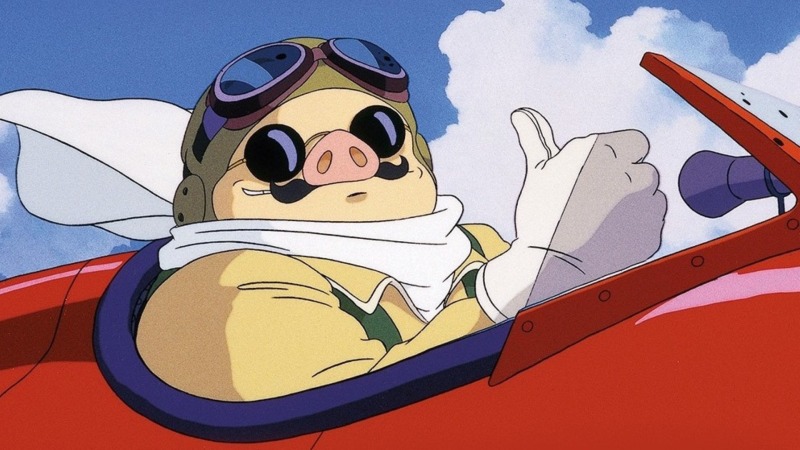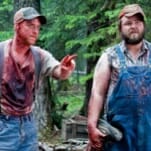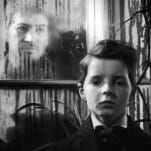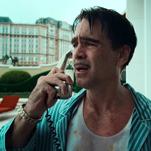Fight Night: Porco Rosso’s Final Dogfight Spanned Land, Sea, and Air
Photos via Studio Ghibli
Conflict is the most basic building block of story, and a fight is the most simple conflict there is: Two people come to blows, and one must triumph over the other. Fight Night is a regular column in which Ken Lowe revisits some of cinema history’s most momentous, spectacular, and inventive fight scenes, from the brutally simple to the devilishly intricate. Check back here for more entries.
Studio Ghibli is probably the last outfit you’d expect to make a list of exceptional fight scenes. If you’re as familiar with the output of the Japanese animation studio founded by Hayao Miyazaki as I am, then you know the stories of these lavishly animated movies are typically driven more by overcoming inner turmoil and reconciling with misunderstood antagonists than they are about throwin’ down. Yet, Miyazaki and the directors who co-founded the internationally renowned studio with him have turned out some truly incredible visions of battle and chaos at times—always in service of showing the senselessness and tragedy of it all, of course. And certainly, you couldn’t really call any of the scenes of violence in Princess Mononoke, Castle in the Sky, or Grave of the Fireflies a “fight” in the way we mean it for the purposes of this regular column—these are battle scenes.
Yet, in searching for a dogfight to fill this space—that is, an aerial duel between fighter pilots—I found myself struggling to think of a readily available example in film in a movie with enough cultural impact to mention. Your Top Gun and Battle of Britain entries feature plenty of airplanes maneuvering around and spraying bullets everywhere, but these are always squad affairs, or one outnumbered pilot scrapping with several opponents. Then I remembered Porco Rosso—one of Ghibli’s and Miyazaki’s standouts, even though it took its time making its way to the States. Released in 1992, the film wasn’t dubbed in English until 2005, after Ghibli had secured a distribution deal with Disney that also ensured their movies got some top-tier localizations. And it just so happens to contain one of the studio’s most dazzlingly animated duels, and an actual tense, one-on-one aerial dogfight.
The Film
It looks to be about the 1930s in the Adriatic Sea. With fascism rising in Italy, the Adriatic is also bedeviled by air pirates—guys in fighter planes and flying fortresses who try to rob ocean liners and otherwise cause trouble. From a hidden cove where he lounges like a boss between sorties, the Adriatic’s best bounty hunter waits for distress calls before taking to the air in his hot rod red seaplane. He’s known as “Porco Rosso,” the Crimson Pig. He just so happens to actually be an anthropomorphic pig—cursed with the visage for reasons he keeps to himself. This is the only magical thing in the movie, this curse. Nobody is hung up on this! Everybody treats it as a fact of life!
Porco is introduced thoroughly outclassing a flying fortress full of air pirates who have brazenly stolen bags of money and 15 rowdy grade-school girls. The movie is not interested in grim and gritty combat: You get all the thrill of soaring wings and blazing guns without any blood or bodies. After gently shooting down the pirates without casualties, he even lets them keep some of the money to repair their plane—they’re his meal ticket, after all. The following scene, in which Porco is overwhelmed by the heedless gaggle of girls, is perfect shorthand for the movie’s tone. Porco (voiced with Bogart-worthy deadpan by Michael Keaton in the English dub) spends the movie insisting he’s a stony tough guy when every moll in the Adriatic can see he’s a softy underneath it all.
At the idyllic hotel and tavern where all the pilots cool their heels under a nonaggression truce, we see that Porco’s reputation has made the air pirates determined to shoot him down, and they have contracted an American hotshot to help them, Curtis (Cary Elwes in the dub). We also see that Porco is admired by the hotel’s maven and head songstress, Gina (Susan Egan in the dub, whose voice you’ll instantly recognize as Megara from Disney’s Hercules). Curtis manages to get in a lucky shot at Porco, briefly stranding him and sending him to Milan, where he can get his plane repaired and where there also happens to be a bounty on his head for that time he deserted from the Italian air force. (As Porco memorably tells an old friend who has decided to go along to get along in Mussolini’s regime: “I’d rather be a pig than a fascist.”)
Porco’s plane is completely refurbished and retrofitted by his kindly old mechanic friend and his teen granddaughter Fio, who takes a liking to the gruff old pig. She insists on accompanying him on his mission to avenge himself on Curtis, both of them giving Il Duce’s goons the slip in a brilliantly animated chase sequence that tasks Porco with piloting his seaplane through Milan’s canals at top speed. Everything in this movie looks like the prettiest painting of Italy or Yugoslavia you’ve ever seen in your life.
Fio is able to penetrate some of Porco’s emotional armor, learning the likely reason behind his cursed visage, and the reason he is so reflexively self-deprecating and self-effacing. “I’m a pig,” he repeats, always to excuse himself from some higher calling: He doesn’t fight for honor, he fights for a paycheck. As Fio discovers, and as we can see pretty much from the start, it’s a defense mechanism, a belief that allows him to continue punishing himself for his failure to protect his friends, a means of giving himself permission to believe he’s no good.
But, those who love him know better. Through her own bluster, Fio manages to set up an honor duel between Porco and Curtis. The stakes: Fio’s hand in marriage to Curtis if he wins (she’s 17!!!! He’s Cary Elwes!!!!!!), and Porco’s repair debts paid off by Curtis if Porco should triumph.
And so, the stage is set, with an eager audience of yachters and air pirates to observe these knights of the air.
The Fight
If he ever does stop making animated films, one chief aspect of Miyazaki’s legacy will surely be that nobody in the history of the medium loves old timey airplanes as much as him. Porco Rosso is, among other things, a love letter to the tactile and daring age of ’30s aviation—a premise I’m always ready to revisit. Called a “Savoia S-21” in the movie, Porco’s plane seems to be modeled on overhead-mounted engine racing seaplanes like the SIAI S.21 and the Macchi M.33. (You will note that one of them used a “Curtiss” brand engine.) Nothing in the movie is more lavishly animated than the planes, which caper through the sky with a true sense of momentum and maneuverability, always with elements like clouds above or the countryside or ocean below to give the viewer a sense of scale.
That’s just the canvas on which the fight is being drawn, though. Once Fio has placed herself in a chair symbolizing that she is at stake, the two belligerents get their birds in the air and the battle begins in earnest. The fight’s early beats feature Porco trying to outwit his more merciless and cocky opponent, using low-altitude flying to throw off his opponent’s aim and then using his plane’s better maneuverability to loop behind his enemy. But, he won’t actually kill his foe, so Porco holds off from firing even as his enemy lights up the whole ocean pursuing him.
It really looks like it’ll be a violent death struggle for a minute, but then … both combatants run out of ammo. And then the fight takes a completely different turn, as they two jockeys hurl insults and whatever they’ve got rattling around loose in the cockpit at each other—they aren’t as good at leading their targets when they’re throwing things, so one shot showcases the two pilots littering the sky with junk while cussing one another out.
Eventually they land and resort to fisticuffs. And even as this is silly and feels low-stakes, it’s still animated with verve. Porco and Curtis wallop each other for a couple of minutes. Their faces look like roadkill by the end of it, even as neither will give up. It is during this exchange that the real motivation behind the fight comes out: Curtis proposed to Gina, who actually is waiting on Porco to get out of his funk and profess his love for her. Porco is faced with the unavoidable fact that he isn’t worthless or unlovable. It defeats him in one way, and carries him to victory in quite another. The two combatants fall into the water, down for the count, and Porco is the first to resurface, and so the winner.
He’s won his honor of course, whatever that might be worth. But there’s no time to celebrate, because the Italians have caught wind of the duel and are coming to arrest him and any other air pirates they don’t like. Their rivalry settled, Curtis and Porco resolve to lead the fascists on a merry chase to cover for the spectators’ escape, and Curtis notices a change to Porco’s face.
The movie makes the daring choice not to dwell on Porco’s victory—Fio tells us that whatever may have happened between him and Gina is their secret. But we see a bright red plane, moored alongside the garden where she has awaited him.
The Fallout
Porco Rosso has won a place of acclaim among aficionados of Ghibli’s catalog as one of the studio’s lesser-known-in-America hits, because it was only ever released here long after its debut. It’s a standout as a unique entry—less weighty than titles like Spirited Away or Princess Mononoke, but with a fantastical and heroic-fiction streak like Castle in the Sky. What resonates now even more than it did then is the movie’s anti-war, anti-violence messages and its ever-present subtext of fascist Europe. Miyazaki (b. 1941), who wrote and directed Porco Rosso, has never once let Japan off the hook for its own history of war—in one way, his writing and directing career can be seen as a pure rebuke of the WWII-era militarism into which he was born.
There’s a reason Porco Rosso screenshots went viral in Spain in 2023, with anti-fascist voters there repeating that same line as its dubbed in Spanish: “Mejor cerdo que fascista.”
Yet, film enthusiasts who also happen to hunger for prop engines and tracer rounds might not be able to find a more gorgeously rendered dogfight on the silver screen. It’s the movie’s thrilling centerpiece, even if its message is that all guns should go silent.
Join us next time as we GET AWAY FROM HER, YOU BITCH, and revisit the extremely moist throwdown between Ripley and the Queen alien in Aliens.
Kenneth Lowe leaves the politics to the humans. You can follow him on Bluesky @illusiveken.bsky.social, and buy his fantasy novel here.







































